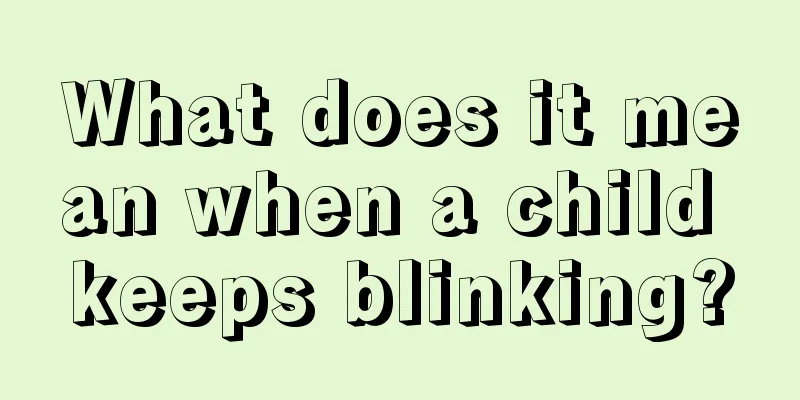What does it mean when a child keeps blinking?

|
What does it mean if a child keeps blinking? Is it normal for a child to blink? Blinking is normal, but blinking frequently is not normal. What causes frequent blinking and how to deal with it? These are what parents should know. Frequent blinking is very harmful to your children, so the symptoms should be eliminated as soon as possible. Under normal circumstances, children blink an average of 15-20 times per minute. Blinking allows the tear film to be normally distributed on the surface of the eyeball, which can protect the cornea, prevent the surface of the eyeball from drying out, and prevent damage from dust. However, frequent blinking is a pathological phenomenon. Let's take a look at what diseases children who blink frequently are prone to? The child keeps blinking. Under normal circumstances, a child blinks an average of 15-20 times per minute. Blinking allows the tear film to be normally distributed on the surface of the eyeball, which can protect the cornea, prevent the surface of the eyeball from drying out, and prevent damage from dust, etc. However, if a child keeps blinking, it is a pathological phenomenon. It turns out that under normal circumstances, children blink an average of 15-20 times per minute. Blinking allows the tear film to be normally distributed on the surface of the eyeball, which can protect the cornea, prevent the surface of the eyeball from drying out, and prevent damage from dust, etc. However, frequent blinking is a pathological phenomenon. So what are the common causes and treatments for children who keep blinking? Inflammatory stimulation: This is the most common cause, which may be caused by infections such as bacteria, viruses, chlamydia, such as conjunctivitis, keratitis, etc. In addition to increased blinking, there are also symptoms such as: redness and itching of the eyes, increased secretions, and tears. Xiaoxin belongs to this situation. To treat frequent blinking caused by bacterial inflammatory stimulation, you can use tobramycin eye drops or 0.1% rifampicin eye drops 3-6 times a day, or apply antibiotic eye ointments such as erythromycin once a night. In severe cases, the frequency of eye drops application can be increased to once every 1-2 hours. If the inflammation is caused by a virus, use acyclovir or endafin eye drops every 1-2 hours. Severe cases require systemic medication. Congenital entropion and trichiasis: Some children are born with congenital inverted eyelids (medically known as eyelids), which causes the eyelashes to fall on the surface of the eyeball, irritating the cornea (the surface of the black eyeball) and causing tears. In this case, entropion of the lower eyelid is the most common, and careful parents can discover it. In terms of treatment, for mild cases, the eyelid can be gently turned outward to its normal position and fixed with adhesive tape applied to the local skin. As the child's body develops, the entropion is expected to heal itself. Severe cases require surgical correction. Attention Deficit Hyperactivity Disorder (ADHD) in children refers to the sudden, involuntary contraction and movement of a certain part of the child's body, such as blinking, frowning, twisting the mouth, shrugging, etc., as well as changes in inattention and hyperactive behavior. Some children will also make strange noises, or even swear and use dirty words. This condition is medically called Attention Deficit Hyperactivity Disorder (ADHD) and Foul Words Syndrome. The cause of the disease is still unclear, but it may be related to mental factors, such as mental stress and emotional instability. Xiao Ming mentioned above belongs to this category. This disease seriously affects children's normal life, study and mental health. Treatment is mainly based on behavior correction. Parents should cooperate with the doctor to provide timely reminders to help their children control themselves, but they should not be too impatient and should not scold or beat their children. They need to gradually guide and persuade their children patiently. Eye fatigue blinking: includes visual fatigue, such as refractive errors, especially uncorrected hyperopia, myopia, and astigmatism, which cause visual fatigue of the eyes. This is a protective reflex that adjusts the curvature of the eyeball through continuous blinking, allowing for clear vision. In this case, you should arrange the child's study and life appropriately, tell the child not to read, watch TV or use the computer for too long, urge the child to do eye exercises, and have his eyes tested and wear glasses when necessary. A child's blinking indicates that there are certain problems. Parents need to find out the reasons and prescribe the right medicine to avoid worsening some diseases. A child's frequent blinking may be a local manifestation of certain diseases. The specific situation still requires further examination and detailed analysis. Parents must not be careless. |
<<: What should I do if my eleven-month-old baby doesn’t like to eat?
>>: What to do if your child has a low-grade fever and cough
Recommend
Is medication effective for children’s pharyngitis? What is the best way to deal with it?
Children's respiratory diseases have a partic...
Normal sleep time for a 2-year-old baby
It is such a happy thing when a new little member...
Whose blood type does the baby inherit?
Everyone has a blood type, which is mainly determ...
What are the preventive measures for chickenpox?
Varicella is a relatively common acute infectious...
What are the symptoms of conjunctivitis in children?
We all know that children are very active. When t...
How tall is normal for a one-year-old baby?
Nowadays, many parents measure their children'...
Why does it happen when babies have milk curds when drinking formula?
Many babies often have curdled stools after eatin...
How to supplement zinc and iron deficiency in babies
For newborn babies, if they are deficient in zinc...
How to deal with a baby's skin breakage
Because the baby's physical development is no...
What vaccines should a 2-month-old baby get?
In modern life, medical scientists have invented ...
Why does the child cry suddenly at night?
If a child suddenly starts crying loudly at night...
What are the harms of smoking to teenagers
Smoking is a very bad lifestyle habit. Long-term ...
What are the signs of intellectual development in a 12-month-old baby?
We all know that when a newborn is born, it repre...
What is the treatment for papular dermatitis in children?
Female friends who have become mothers may have h...
How to treat lymphadenitis in children
Lymph node inflammation usually comes in two type...









